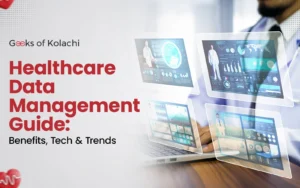
Top Medicine Delivery App Development Solutions for 2025: Features, Cost, & Benefits
The healthcare industry is undergoing a rapid transformation, and medicine delivery app development is at the forefront of this change. These apps are making it easier than ever for people to access medications—whether they’re in urban centers or remote areas. Imagine ordering your prescription meds from the comfort of your home and having them delivered right to your doorstep—medical delivery app development is making that possible. In this blog, we’ll dive deep into the process of building a successful medicine delivery app, covering everything from key features to cost considerations and best practices.
What is a Medicine Delivery App?
In the simplest terms, a medicine delivery app is a digital platform that allows users to order medicines and have them delivered to their homes. With healthcare becoming more accessible online, these apps have become increasingly popular, especially since the onset of the COVID-19 pandemic. People now have the convenience of ordering their medications from the comfort of their homes without the hassle of physically visiting a pharmacy.
These apps often come with built-in features such as prescription upload and verification, real-time order tracking, and secure online payment systems. Not only do they help customers save time, but they also improve medication adherence by ensuring timely deliveries.
For pharmacies, the app serves as an excellent tool for expanding their customer base. Whether you own a small local pharmacy or a large chain, creating a medicine delivery app for drivers can open doors to new revenue streams and enable you to cater to a wider audience, including those who may not be able to visit in person.
Why Invest in Medicine Delivery App Development?
The demand for development of medical delivery apps is growing at an exponential rate. According to market research, the global e-pharmacy market is expected to reach a value of $242 billion by 2031, with the medicine delivery app USA leading the charge. For more detailed insights, check out this e-pharmacy market growth and forecasts.
So, why should you consider investing in a medicine delivery app?
- Increased Demand for Convenience: People are looking for solutions that make their lives easier. Medicine delivery apps provide the convenience of getting prescriptions delivered right to your door without stepping outside.
- Wide Market Reach: With the rise of smartphones, more and more customers are opting for online services. Whether you’re targeting urban or rural areas, medicine delivery app development solutions ensures that you’re available to meet the needs of a wider audience, including those in remote areas with limited access to physical pharmacies.
- Health and Safety: In the post-pandemic world, health and safety are top priorities. By offering an app that allows users to order medication from home, you reduce the need for physical visits to pharmacies, helping curb the spread of diseases.
- Growing Healthcare Market: With healthcare evolving into the digital space, medicine delivery applications are a lucrative investment. Apps help pharmacies improve their inventory management and provide timely services, which in turn improves customer satisfaction.
If you want to stay ahead, it’s also helpful to keep an eye on the latest trends in healthcare software development to understand how digital tools are reshaping patient care.
If you’re exploring how to create an app that fits into the healthcare ecosystem seamlessly, consider leveraging trusted healthcare software solutions that specialize in healthcare-specific challenges and regulations.
Key Features of a Medicine Delivery App:
Building a successful online medicine delivery app isn’t just about developing a functional app. It’s about providing a seamless, easy-to-use experience for customers. Let’s break down some key features that will make your app stand out:
-
User-friendly Interface
When it comes to apps, usability is key. Your app should have a simple, clean, and intuitive design that allows users to browse and order medicines with ease. Avoid clutter and focus on a smooth user experience that guides the customer from browsing to checkout with minimal effort.
-
Prescription Upload and Verification
For prescription-based medicines, users should be able to upload their prescriptions directly within the pharmacy app development. The app should have a secure system for verifying prescriptions to ensure that the right medication is delivered to the right person. This feature is crucial for ensuring compliance with regulations like HIPAA in the medicine home delivery app.
-
Real-Time Order Tracking
Customers appreciate transparency, and the ability to track their orders in real time can make the delivery process feel more secure and reliable. Medicine delivery apps should include GPS tracking that allows users to see the delivery progress and estimated arrival time.
-
Multiple Payment Options
Offering a variety of secure payment methods, including credit/debit cards, net banking, e-wallets, and even cash on delivery, is essential to cater to different user preferences. Payment gateways should be integrated securely, ensuring a smooth transaction process every time.
-
Delivery Management and Notifications
Your delivery app for medicine should have an integrated delivery system that allows delivery partners to receive notifications, track their routes, and update the status of deliveries. This feature is especially important for ensuring that deliveries are made on time and customers are notified about the status of their orders.
-
Customer Feedback and Rating
Allowing users to rate and review their experiences helps build trust with new customers. By gathering valuable feedback, you can continuously improve your services, ensuring that your delivery app is always evolving.
-
Push Notifications and Reminder
Push notifications are a great way to engage users and keep them informed. These can be used to notify customers about new products, discounts, or upcoming prescription refills. For patients with chronic conditions, reminders for medication refills are crucial to ensuring that they stay on top of their treatments.
If your project needs something unique, collaborating with a team experienced in bespoke software development tailored to your needs can make all the difference in creating a personalized and efficient medicine delivery app.
To dive deeper into the development process, you might find this comprehensive guide to medicine delivery app development very useful.
| If you’re thinking about building a medicine delivery app but aren’t sure where to start, feel free to get in touch. We’d be happy to chat and help you explore your options. |
How Do Medicine Delivery Apps Work?
Now that we’ve discussed the essential features of the best app for medicine delivery, let’s dive into the process of how these apps actually work:
-
Creating an Account:
Users begin by creating an account in the app. They can fill in their personal details, including their address and payment methods.
-
Browsing Medicine Catalog:
Once the account is set up, users can browse a comprehensive catalog of medicines. They can search by name, category, or even by brand. The online pharmacy app development solution should also provide useful information about each product, including dosage instructions and potential side effects.
-
Prescription Upload:
For prescription-only medicines, users can easily upload their prescriptions. The app will verify the prescription, either manually or through automated AI systems, to ensure accuracy before allowing the user to proceed with the order.
-
Order Placement and Payment:
After verifying the prescription, the user can add the medicine to their cart and proceed to checkout. The payment process is secure, with various payment methods available to suit the customer’s needs.
-
Order Processing and Delivery:
Once the order is confirmed, your instant medicine delivery app connects with the nearest pharmacy that has the medication in stock. The app uses real-time data to coordinate with delivery drivers and ensure that the medication is delivered promptly.
-
Real-Time Tracking:
As the order is being delivered, users can track their package in real time, with updates on the delivery status. This feature adds a layer of trust and transparency to the service.
To understand how quality assurance improves healthcare software safety, you might want to explore best practices in QA to ensure your app meets all compliance and safety standards.
Understanding the key benefits of AI in healthcare can also help you explore ways to integrate intelligent features into your app to enhance user experience.
Technology Stack for Medicine Delivery App Development
When developing an app medicine delivery, choosing the right technology stack is critical for ensuring that your app is scalable, secure, and efficient. Here’s a breakdown of the tech stack that will support your app:
-
Frontend Development:
For mobile apps, technologies like React Native or Flutter are ideal for building cross-platform apps. These tools ensure that your app for medicine delivery at home performs well on both iOS and Android devices without the need for separate codebases.
-
Backend Development
Technologies like Node.js and Express.js are commonly used for building backend services that handle the logic behind the scenes. These tools ensure that the app performs efficiently as the fastest medicine delivery app, even under heavy loads, and enables real-time data processing for features like order tracking.
-
Database Management
The database stores all the important data like customer details, orders, inventory, and payment information. Popular databases like MySQL or MongoDB are commonly used in medicine delivery app development because they support fast data retrieval and scalability.
-
Third-Party API Integrations
Integrating with third-party services is essential for functionalities like payment processing (e.g., Stripe or PayPal), maps and GPS services (e.g., Google Maps API), and prescription verification systems. These integrations add functionality to your app for home delivery of medicine without the need to build everything from scratch.
-
Cloud Hosting
Using cloud hosting services like AWS or Google Cloud ensures that your app can handle large amounts of data and traffic. It also helps keep your app secure and easily scalable as your user base grows.
Business Models for Medicine Delivery Apps
There are primarily two business models for building the best online medicine delivery app:
1. Aggregator Model
This model connects users with third-party pharmacies and delivery drivers. The app simply acts as an intermediary between the customer and the pharmacy, handling orders and payments. Revenue is typically generated through commissions or service fees.
2. Inventory-based Model
In this model, the app operates its own pharmacy and manages its inventory. The business sells its own medicines directly to users. This model requires more investment upfront, but it allows for better control over pricing and inventory.
Cost of Developing a Medicine Delivery App
The cost of an online medicine delivery app development can vary greatly depending on various factors like features, platform, and complexity. On average, the development cost can range from $20,000 to $50,000 for a basic app, while a more advanced app that delivers medicine with custom features and integrations can cost upwards of $100,000.
Factors that affect cost include:
- The complexity of the features (e.g., AI integration, prescription verification)
- Whether the app is for iOS, Android, or both
- The geographical location of the development team
How to Choose a Medicine Delivery App Development Company?
When choosing a company that provides services related to a delivery software for medicines, it’s important to select a team that has experience in building healthcare apps. Look for companies that:
- Understand healthcare regulations like HIPAA
- Have experience with secure payment systems and prescription verification
- Offer post-launch support and maintenance
Conclusion
As the world continues to shift toward digital healthcare, medicine delivery app development is becoming an essential service for pharmacies looking to stay competitive. With the right features, technology stack, and business model, you can create an app that not only serves the needs of your customers but also provides a seamless, secure, and efficient solution for medication delivery.
By investing in medical delivery app development, you can tap into a rapidly growing market and provide a valuable service that benefits both customers and healthcare providers alike.
| Interested in learning how a custom medicine delivery app can work for your business? Reach out anytime — we’re here to help you bring your ideas to life. |
Frequently Asked Questions
1. What is medicine delivery app development?
Medicine delivery app development is the process of creating mobile and web apps that allow users to order medicines online and have them delivered to their doorstep. These apps usually include features like prescription upload, real-time tracking, and secure payments to ensure convenience and safety.
2. How much does it cost to develop a medicine delivery app?
The cost varies depending on features, platform, and complexity. On average, a basic medicine delivery app can cost between $20,000 and $50,000, while advanced apps with custom integrations and AI-driven features can exceed $100,000.
3. What are the key features of a medicine delivery app?
Key features include a user-friendly interface, prescription upload and verification, real-time order tracking, multiple secure payment options, delivery management and notifications, customer feedback, and push notifications for order updates and medication reminders.
4. How long does it take to develop a medicine delivery app?
Development typically takes between 3 to 6 months, depending on the app’s complexity, number of features, and whether it’s built for one or multiple platforms (iOS and Android).
5. Why should healthcare businesses invest in medicine delivery app development?
Investing in medicine delivery apps expands market reach, enhances customer convenience, supports timely medicine delivery, and opens new revenue streams in the growing digital healthcare market.
6. How do medicine delivery apps ensure the authenticity of medications?
These apps partner exclusively with licensed and certified pharmacies. They maintain strict quality control through pharmacy credential verification, regular audits, and compliance with healthcare regulations to ensure that customers receive genuine and safe medicines.
7. What security measures protect user data in medicine delivery apps?
Medicine delivery apps use strong encryption, comply with healthcare regulations such as HIPAA, and integrate secure payment gateways to protect users’ personal and payment information.
8. Can users schedule medicine deliveries in advance?
Yes, many medicine delivery apps offer features like advance scheduling and recurring orders to help users manage their medication needs efficiently.
9. Are subscription models or loyalty programs available?
Some medicine delivery apps provide subscription plans and loyalty programs that offer discounts, rewards, and other benefits to frequent users.
10. How do medicine delivery apps handle urgent or emergency orders?
Certain apps prioritize urgent orders and offer expedited delivery options to ensure critical medications reach customers quickly.
11. What should users do if they receive the wrong medication?
Users should immediately contact customer support via the app to report the issue. The app typically provides a clear process for verification, return, and replacement of incorrect orders.
12. Are there geographical limitations for medicine delivery services?
Delivery areas vary by app and pharmacy partnerships. Most apps specify their service regions and may have limitations based on local laws and logistics.
13. How can pharmacies integrate with a medicine delivery app?
Pharmacies can usually onboard by partnering with the app provider, undergoing verification, and syncing their inventory. This enables them to manage orders and expand their customer base through the platform.
14. What environmental impact do medicine delivery apps have?
Many medicine delivery services are adopting eco-friendly packaging and optimizing delivery routes to reduce carbon footprints and promote sustainable practices.
15. How can users provide feedback or rate the medicine delivery service?
Most apps include a customer feedback and rating system where users can review their experience, helping the service improve continuously.



















